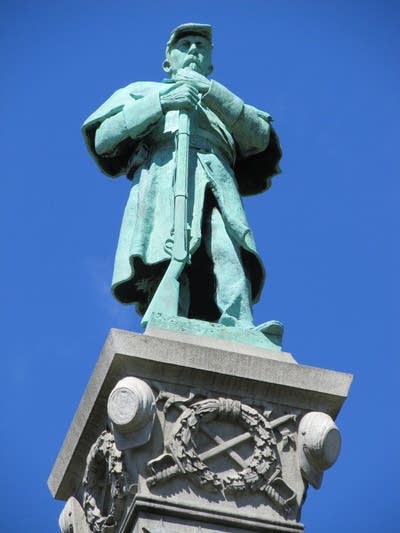Minnesota's Gettysburg charge was long on courage, short on strategic import

It's a point of pride hereabouts that a small regiment of Minnesota soldiers helped delay a Confederate advance during the Battle of Gettysburg. With the 150th anniversary of that Civil War battle approaching, The Daily Circuit invited a historian from Virginia to discuss Minnesota's role in the fight and just how far the state's bragging rights should extend.
After all, if Minnesota saved the day at Gettysburg, and the victory at Gettysburg won the war for the North, then Minnesota gets the credit for winning the Civil War. Right?
"It did not save the day for the Union Army," said Prof. Gary Gallagher, who teaches history at the University of Virginia. "It was a splendid charge, and it was made at great cost, but the Confederate assaults were really not going to accomplish anything further that day."
But victory at Gettysburg did lead to the South's defeat, right?
Create a More Connected Minnesota
MPR News is your trusted resource for the news you need. With your support, MPR News brings accessible, courageous journalism and authentic conversation to everyone - free of paywalls and barriers. Your gift makes a difference.
Well, no.
Gettysburg "was not the turning point of the Civil War. That's a very common misconception now," Gallagher said. "What it did do was mark the end of a huge run of success that the Army of Northern Virginia had had at Fredricksburg and then Chancellorsville, and it helped the Union cause at a very difficult time. There was great political upheaval because of Emancipation, because of conscription in the United States, so Gettysburg was badly needed. Absolutely.
"But did it change the direction of the war? It did not. And Abraham Lincoln understood that. He predicted right after Gettysburg that because [Maj. Gen. George] Meade didn't follow up, the war would continue indefinitely."
As he summed up: "The Republic did not hang in the balance when the First Minnesota made its attack."
A Confederate victory at Gettysburg, he said, "would have been very bad news politically for the Lincoln administration. It would have been almost catastrophic. Militarily, I don't think [Gen. Robert E.] Lee had the capacity to deliver a knockout blow to the Army of the Potomac. But politically, it would have vastly complicated Lincoln's life, and it would have given far more energy to the antiwar element of the Democratic Party, the Copperheads, who reached their high point just before the battle of Gettysburg. The draft riots at New York City came right after Gettysburg. It was a very fraught time for the United States, and a Confederate victory would have made it all the more fraught."
Even as he downplayed the significance of Minnesota's famous charge at Gettysburg, Gallagher said that it demonstrated a spirit of sacrifice that seems unimaginable today.
"This is a perfect example of why, in studying history, we need to remember that the past isn't just like us only a long time ago. It's an entirely different culture, a different conception of what a citizen soldier was," he said. "It's a very different time. And soldiers then would do things that they will not do now. First Minnesota had hideous casualties. Among all the Union regiments at Gettysburg, they had the third-highest percentage of killed, they had the second-highest percentage of wounded ... they and many other units like them did things that I think we simply can't imagine doing now."
Gallagher told the story of how the First Minnesota came to its fateful moment.
"The first day at Gettysburg was a huge tactical success for the Confederates, and Lee hoped to follow up on the second with a knockout blow," he recounted. "It played out as a series of Confederate assaults against both ends of the United States position.
"We don't know how many men were present for the First Minnesota that day. The traditional number is 262, but recent scholarship suggests at least 290, and perhaps 300, which was a little small for a regiment at Gettysburg ... but it was the available unit and [Major General Winfield Scott] Hancock saw them. And a Confederate brigade of Alabamians, more than 1,700 of them, were approaching, and Hancock sent the First Minnesota into the fight there.
"They came off Cemetery Hill toward a little creek called Plum Run, and collided with the Alabamians, and stopped that part of the Confederate attack. Pretty soon both their flanks were overlapped by Cadmus Wilcox's Alabama Brigade. He had so many more men that he could threaten both flanks of the First Minnesota once they got to Plum Run."
Gallagher said the Minnesota charge "certainly bought some time. I think the main thing it did was create doubt in Wilcox's mind. Wilcox didn't have anybody supporting him on either flank, and no reinforcements coming up either. ... I think he felt isolated, even though he had a much smaller unit in front of him. I think the attack of the First Minnesota contributed to this state of mind that Wilcox had, that eventually led him to withdraw."
WATCH PART OF THE KEN BURNS DOCUMENTARY, 'THE CIVIL WAR':
